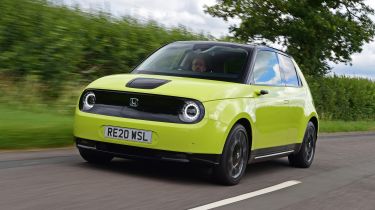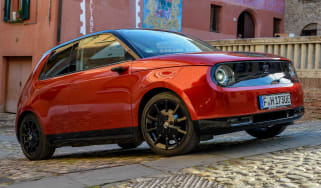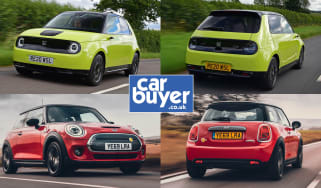Honda e hatchback review (2020-2024)
“The Honda e is a very desirable electric car, even if improved range would increase its appeal”
Pros
- Charming retro looks
- Nippy acceleration
- Hi-tech interior
Cons
- Expensive
- Shorter range than rivals
- Small boot
A couple of years ago, you had a rather limited choice if you wanted a small, funky electric car. The Honda e sits in a part of the market that is becoming more congested, competing against EV stalwarts like the Renault ZOE and BMW i3, as well as newcomers like the MINI Electric, Peugeot e-208 and the new electric Fiat 500.
You could argue that, i3 excepted, none of those cars will draw as much attention as the Honda e. The striking retro lines, round headlights and black grille are barely changed from the concept first shown in 2017, and although Honda never intended to make a production version of that Urban EV prototype, the reaction to the car’s styling was too positive to ignore.
 The smallest cars on sale in 2025
The smallest cars on sale in 2025
The minor differences between the Honda e and the concept are a contrasting black roof, five doors instead of three, and a taller bonnet, but the production model has retained the hi-tech touches and funky front end of the concept, along with its retracting door handles.
State-of-the-art features include high-definition cameras taking the place of traditional wing mirrors and interior screens that seem to stretch right across the dashboard from door to door. Two 12.3-inch touchscreens control the infotainment, and these can be individually configured and swapped around. There isn’t a car with an interior quite like the Honda e’s, especially in this price range, and the tech is complemented by faux wood trim and grey fabric chosen to mimic the feel of a sofa.
While the looks will undoubtedly attract interested customers, the Honda e stacks up less well when you consider the full package. It’s more expensive to buy than the MINI and the ZOE - costing more than the big Honda CR-V SUV - and its maximum range is a little limiting. Practicality is hardly its strongest area, either.
There are two trim levels - base and Advance - and neither feel short of equipment. High-resolution cameras take the place of wing mirrors and are standard, unlike on the Audi e-tron SUV where they’re an option on a car that is around double the price. The Honda e also comes with Apple CarPlay and Android Auto, keyless entry and start (and the ability to unlock the car with compatible smartphones), pop-out door handles, LED lights and a rear-view camera.
The Honda e’s range is slightly disappointing at 137 miles (125 for cars with the biggest wheels), which is considerably less than the Renault ZOE and Peugeot e-208, but about the same as the Mazda MX-30. Batteries are heavy, so it’s a choice of a longer range or a more exciting driving experience, and Honda has opted for the latter. The range should still be plenty for most people, with the average driver only needing to recharge every few days. Handily, fast-charging is standard if you do need to drive further afield.
The Honda e has a smaller turning circle than a London taxi, so it’s incredibly manoeuvrable and parking is super-easy. The instant surge of torque from the electric motor gives quick acceleration and while it may be a city car, the Honda e isn’t out of its depth when you find yourself on a twisty back road.
Hondas are renowned for their near-bulletproof reliability, and we’ll have to wait to see if the e can live up to that reputation. Electric cars have fewer moving parts so, in theory, there’s less to go wrong, but the Honda e does sit on a bespoke new platform. The Honda e is fitted with a full roster of standard driver assistance systems and has a four-star Euro NCAP safety rating.
If the Honda e's range isn't an issue for you, this is a superb electric city car, one that's good to drive, stylish and has plenty of interesting tech to keep gadget-lovers occupied.















